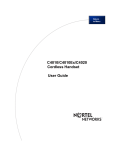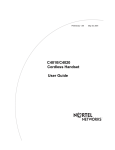Download Saitek Pro Bridge 510 Troubleshooting guide
Transcript
Screen, keys and features 4. The Link to Pro Bridge 510 4.1 What it does 4.2 Connecting 4.3 Disconnecting the Link 1. Introduction 2. Getting Started Playing your first game 2.1 Installing the batteries 2.2 Dealing 2.3 Bidding 2.4 Playing the hand 2.5 The result 3. 3.1 3.2 3.3 3.4 3.5 3.6 3.7 3.8 3.9 5. Technical Details 6. Troubleshooting Guide APPENDIX – Bidding System – Scoring Other features Changing the bidding system Hint View Information Claim Replay hand Redeal View Hands Numbered deals Score AAA/AM4/RO3 Mini penlite 1 ENGLISH TABLE OF CONTENTS Screen, keys and features ∏ J 8 4 3 J I0 8 4 PRESS ENTER NS WEST VULNER LINK EW NORTH EAST ⁄ VIEW HANDS 2 ♣ ♥ ¤ SCORE K ‹ VIEW INFO ♠A ♥A ♦ › SCROLL ♠ fi SOUTH DUMMY ♣ ♦ ♣ ♣ ♠ Q ♥ ♦ Q ♣ 9 ♣ J I0 ♣A 4 3 I0 9 8 3 Ø 6 2 4 T BID M ENTER P fl OP /ST ‡ ‚ · UM  N ♠ DOUBLE Ê PASS ♥ Á ♦ „ D UN ° 1 R OT È STEM GO 3 5 9 HI SY N 7 10 RE 8 J Q CLAI Œ K SO P R O B R I D G E 3 1 0 A ⁄ LCD screen Displays all the information needed to play. ¤ SCORE Press to see score of rubber. ‹ VIEW HANDS Press and hold to see NS or EW hands. › VIEW INFO Shows number of tricks made so far, current contract and current bidding systems. fi SCROLL Press to select number of remaining tricks to be claimed by NS and EW, or to view further information in VIEW INFO. fl SOUND Press to turn sound on/off. ‡ HINT/SYSTEM Press before dealing to change bidding systems. During playing/bidding, press to ask computer for suggestions. ° REBID Press to replay the same deal. · CLAIM Lets you claim some or all of the remaining tricks. ‚ GO/STOP Press to turn computer on/off. Bidding systems, dealer and vulnerability remain the same when you switch on again. ♣ ESCAPE Ë 2 Œ Value keys Each card value from the two to the Ace has a key. “1” is for use in bidding. „ Suit keys Each suit has its own key. Plus a NO TRUMP key.  ENTER Press to confirm play/bid/hint/claim, move to the next round of cards being played and to receive a new deal. Ê DOUBLE Doubles the previous bid - indicated by a “d” on the screen. Also lets you redouble, indicated by an “R”. Á PASS To pass on your turn to bid - indicated by “-” on the screen. Ë ESCAPE Press to exit CLAIM, VIEW INFO,SCORE and HINT modes. Press while playing or during bidding to return to DEAL SELECTION. È Battery compartment In base of unit. Ø ACL In base of unit. Used to discharge static after inserting a new battery. ∏ Socket for connecting to Pro Bridge 510. Pro Bridge 310 is a handheld bridge computer ideal for anyone who likes a good game of bridge. If you are a beginner, the accompanying Introduction to Bridge manual can help you understand how to play the game; read it before you begin. Below are just some of the features of the computer: • choose Standard American 5-card majors or ACOL bidding system (see section 3.1). • choose random (shuffled) or numbered (preprogrammed) deals • view all the hands • take advice for the next bid or play • claim some or all of the remaining tricks you think you are going to win (see section 3.4) • check the current scores 3 ENGLISH 1. Introduction 2. Getting started 2.3 Bidding SOUTH flashes when it is your turn to bid. Key in your bid, suit (or No Trumps) and level (number). The computer makes and displays the bids for the other hands. Continue bidding until there are 3 passes. Playing your first game 2.1 Installing the batteries - (see diagram on page 1). Insert 4 mini-penlite AAA/AM4/R03 alkaline batteries. Press GO, if appropriate, to switch on. If the computer does not respond, press a pin or other sharp object into the hole marked ACL in the base of the unit for a few seconds. This resets the computer and you are now ready to play. 2.4 Playing the hand As in a game played by four human players, the bids made decide who is to lead. The player to dummy's right plays the first card unless it is you (South) to lead, the computer plays the card from that hand. The value and suit of the card appear in the middle of the display. Your computer is automatically set to the 5-card majors system.To change the setting to ACOL, see section 3.1. Next dummy’s hand is displayed at the top of the screen (unless South is dummy, when dummy hand is displayed at the bottom of the screen). The word DUMMY appears on the LCD under either West, North, East or South. One of the card symbols on the left of the display is underlined to indicate which suit is trumps, if any. 2.2 Dealing WEST NORTH EAST SOUTH D appears on the LCD. a 1 Press ENTER for a random deal. 4 The computer plays the hands for East and West. It also plays North’s hand unless North is declarer or dummy, when you play both North's and South's EAST DUMMY 3♠ 2.5 The result The result is displayed after the last trick has been played. For example, with declarer playing West, in a contract of 4 spades bid and made, the display shows: 2 ENTER adds the result to the running score and returns to deal selection ESCAPE to go back to deal selection without adding the current result to the score and without changing the dealer. WEST DUMMY = Once the score reaches 20 000, the computer automatically subtracts 20 000 from your number. With declarer playing South, in a contract of 4 spades, bid and made with 1 overtrick: SOUTH DUMMY - Press SCROLL To display the score below the line for the current game. (Declarer's if he made contract, otherwise Defenders') Press SCROLL again to display the score above the line for the current game. Press SCROLL once more to return to the Results display. Press ESCAPE at any time while bidding or playing to terminate the hand and return to deal selection. ♠ 1 or declarer playing East, in a contract of 3 spades, bid but down two tricks: The word SOUTH flashes on your turn to play. If you are also playing North, NORTH flashes on its turn. Once the trick is complete the four cards are displayed until you press ENTER to start play for the next trick. If you have only one card in the suit being played, it is played automatically for you on your turn. 4 P 5 ENGLISH 4♠ hands. Press ESCAPE to return to Deal Selection. 3. Other features 3.1 Changing the bidding system Your computer is automatically set to 5-card majors when you first start playing. To change to ACOL: • DEAL appears on the display when you switch the computer on or go back to the Deal Selection menu. Before pressing ENTER for a random deal, press HINT/ SYSTEM. • The display shows: WEST SOUTH 5 5 3.2 HINT For advice during bidding or play, press HINT. Press ENTER to accept the suggested bid or play. Press HINT again (or ESCAPE) to go back to the game without using the hint. 3.3 VIEW INFORMATION You can check the number of tricks made, the contract and the bidding systems at any time during the game by pressing VIEW INFO followed by SCROLL to step through the options. The display shows successively: RECALL TRICKS RECALL CONTRACT RECALL (for bidding systems) SOUTH flashes. To change South (NS) to ACOL, press “A” (the Ace key) followed by SCROLL. WEST begins to flash. Press A again. To change back to 5-card majors, press “5”. Use the SCROLL key to switch between the two pairs (EW and NS). except during deal selection, bidding or when the result is displayed when it just shows the bidding system in use. You can use different systems for EW and NS if you so wish. Press ESCAPE to return. 6 3.8 Numbered deals Would you like to try a prepared deal that you can recall anytime? When the screen displays deal, press any number between 1 and 9999999999 (the digits shift left as you enter more), then ENTER. If you enter a full 10 digits the computer automatically goes to the bidding phase. If you want to continue playing the hand after pressing CLAIM, press ESCAPE (not ENTER). 3.9 SCORE Press SCORE, then SCROLL repeatedly to see the score in the rubber to date. The display shows: RECALL SCORE BELOW – the current score below the line before a rubber is made (NS then EW). 3.5 Replay hand Press REBID at any time during the game to play the hand again. The dealer rotates as if you pressed rebid when it was showing deal. 3.6 Redeal If you don’t like your hand, press ESCAPE followed by ENTER for a random deal. RECALL SCORE ABOVE – the current score above the line before a rubber is made (NS then EW). RECALL TOTAL – the cumulative score of previous rubber (NS then EW). 3.7 VIEW HANDS Press and hold VIEW HANDS to see North/ South’s hands. Press and hold again to see 7 ENGLISH East/West’s hands. 3.4 CLAIM To claim all the remaining tricks for NS during a game, press CLAIM followed by ENTER. You can claim part of the remaining tricks for NS and EW by pressing SCROLL after pressing CLAIM. Press ENTER when the desired number of tricks for each side appears on the LCD. To set the score to zero press SCROLL until “r s t” (short for “reset”) appears on the display then press ENTER. Press SCROLL to see the above again, or ESCAPE to return without resetting the score. device and should not be subjected to extremes of temperature or rough handling. Use a clean, soft cloth to clean your computer. Do not use chemical cleaning agents as this may damage the casing. 5.4 Technical specifications Processor speed: 3.5 MHz Screen: Liquid Crystal Display (LCD) Keys: 32 Power consumption: 100mW max. Batteries: four 1.5V mini-penlite AAA/AM4/R03; Alkaline type recommended Dimensions: 198 ✕ 108 ✕ 34mm Weight: 0.28 Kg 5. Technical Details 5.1 Weak batteries Weak batteries can cause incorrect displays on the LCD or wrong bids and responses. Always use fresh batteries and replace regularly. Turn the computer off when not in use to conserve power energy. 5.2 ACL key If the computer fails to respond after you have inserted a new set of batteries, your unit may have locked up due to static discharge. Turn off the computer, insert a pin or another sharp object into the hole marked ACL and press down for at least 2 seconds to reset the computer. 5.3 Care and maintenance Your Pro Bridge 310 is a precision electronic Do not use rechargeable batteries. 8 SYMPTOMS POSSIBLE CAUSE WHAT YOU SHOULD DO 1. The unit will not turn on Batteries weak or dead Replace batteries. If problem persists, turn off computer and press a pin into the hole marked ACL (See sect. 5.2) Batteries not inserted properly See page 1 Battery connectors contact poor Check battery connectors 2. Wrong display on LCD Batteries exhausted Replace batteries. If problem persists turn off computer and press a pin into the hole marked ACL (see Sect. 5.2) 3. Illegal bidding Batteries exhausted Replace batteries. If error persists, consult Distribution Center 4. No response or improper Batteries exhausted response Electrostatic discharge Replace batteries 5. Display is dim Batteries weak Replace batteries 6. Computer rejects the card you selected You do not have that card (eg. card in dummy’s hand) Key in correct card You are not following suit Key in correct card Turn off computer. Press a pin into the hole marked ACL (see sect. 5.2) 9 ENGLISH 5. Troubleshooting Guide 4. CABLE CONNECTION 4.1 Introduction 4.2 Connecting Pro Bridge 310 to Pro Bridge 510 Included with every Pro Bridge 510 (and Pro Bridge 500 upgrade kit) is a cable to connect Pro Bridge 310 to Pro Bridge 510. 3. Switch both computers on. 1. Switch off both computers. On Pro Bridge 510: If your Pro Bridge 310 or 510 are already switched on and connected, switch off and switch on again before attempting to link the computers. 4. To start the electronic link: 2. Connect Pro Bridge 310 to Pro Bridge 510 using the cable (see diagram). 4.1 Press ESCAPE until the first menu PCLSD appears on the LCD. Move cursor under C (change setting), press ENTER. 4.2 Pro Bridge 310 always plays South and is always operated by a human player. appears on the LCD. If you are playing on your own, check that North, East and West are computer players. If more than one person is playing, change North, East or West to a human player, as required, (see 5.1 of Pro Bridge 510 manual). 4.3 To start up the electronic link , go to the setting menu as in 4.2. With cursor under 10 C H L Players South : Human. Move cursor under L and press ENTER. The display shows: YN start link Yes – South ready. • You can still use Pro Bridge 310's HINT function, VIEW CONTRACT and TRICKS on your turn when bidding or playing; the VIEW SCORE (for rubber or TOF depending on the level setting of Pro Bridge 510) and SOUND functions also operate. Press ENTER. The word LINK appears on Pro Bridge 310's LCD to show that the computers are ready to be played together. 4.4 Press ENTER (or ESCAPE), followed by ESCAPE on Pro Bridge 510 to start playing by pressing ESCAPE (see manual 3.1 Pro Bridge 510 ). When it is South’s (Pro Bridge 310's) turn to bid or play you cannot operate Pro Bridge 510 (and vice versa). When it is Pro Bridge 510's turn to play, the word LINK flashes on Pro Bridge 310's LCD. • To claim the remaining tricks after any round of play before pressing ENTER, press CLAIM on Pro Bridge 510. Adjust the number of tricks claimed for each side using the SCROLL key and cursor, then press ENTER (sect. 7.6 of your Pro Bridge 510 manual). Press ENTER on Pro Bridge 310 to confirm, or ESCAPE to refuse. • When the connection is up and running 11 ENGLISH some of the functions of Pro Bridge 310 cannot be used. For example, VIEW BIDDING SYSTEMS, CLAIM, SETTING BIDDING SYSTEMS, REBID, can only be operated via Pro Bridge 510. The VIEW HANDS feature depends on the settings for Pro Bridge 510 (see manual 5.7 Pro Bridge 510). H, press ENTER. The LCD shows: Move LCD under N [YN start link. No abort link], press ENTER once more. • At the end of a trick press ENTER on both computers before proceeding to the next round. Pro Bridge 310 plays only rubber bridge. If you were playing duplicate bridge before you disconnected, reset the score on Pro Bridge 310 before you begin (see section 3.9). This ensures that the appropriate rubber bridge scores are displayed on the LCD. • The vulnerability shown on Pro Bridge 310 matches that of Pro Bridge 510 as long as it is in the bidding or playing phases. To redeal, enter South’s bid first (on Pro Bridge 310) followed by ESCAPE, ENTER on Pro Bridge 510. If you have problems linking up the computers, switch off both computers and repeat this entire process from the beginning. 4.3 Disconnecting the Link Turn both machines off; remove the cable. When you next switch on Pro Bridge 510, the menu shows YN start link Yes – South ready 12 12 SYMPTOMS POSSIBLE CAUSE ACTION 1. Pro Bridge 310's CLAIM key will not operate. Pro Bridge 310 is linked to Pro Bridge 510: When the cable is in operation CLAIM can only be operated via Pro Bridge 510. Ask Pro Bridge 510's human player to claim for you on his/her turn. 2. You cannot set the bidding system for NS on Pro Bridge 310. Pro Bridge 310 is linked to Pro Bridge 510: bidding system must be set via Pro Bridge 510. Set the bidding system for NS on Pro Bridge 510. Pro Bridge 310 is linked to Pro 3. Pro Bridge 310's VIEW HANDS function Bridge 510: Pro Bridge 510's viewing option has been will not operate. disabled. Enable the viewing option via Pro Bridge 510 (see section 5.7 of your Pro Bridge 510 manual). 4. Pro Bridge 310's REBID key will not operate. Pro Bridge 310 is linked to Pro Bridge 510: Rebid must be operated via Pro Bridge 510. Continue playing until it is Pro Bridge 510's human player's turn. Press ESCAPE and choose "same deal". 5. Pro Bridge 510/Pro Bridge 310's keys will not operate. It is not your turn. Wait until your turn. 13 ENGLISH Cable Connection Troubleshooting Guide LinkTroubleshooting Guide SYMPTOMS POSSIBLE CAUSE 6. Pro Bridge 310 or Pro Bridge 510 hang up. The cable has disconnected in the middle of a game. Check the cable. If it is loose, switch off both computers, reconnect cable and switch on again. When Pro Bridge 510's menu shows "YN start link", press ENTER on Pro Bridge 510. One of the computers has been switched off or switched off and on again after the computers were linked. Switch off both computers and switch on again. If Pro Bridge 510's menu shows "YN start link", press ENTER on Pro Bridge 510. Otherwise follow the procedure described in the CABLE CONNECTION section. The cable is not connected to both computers. Switch off both computers. Connect the cable. Switch on both computers and follow the procedure described in the CABLE CONNECTION section. If error persists, consult your Disribution Center. 7. Pro Bridge 310 and 510 will not link up : Pro Bridge 510's display shows: "RA link failure Retry". The cable is loose. Pro Bridge 310 is not ready. 14 ACTION Switch off Pro Bridge 310, then switch it on again. Press ENTER on Pro Bridge 510 when Pro Bridge 510's menu shows "YN start link". 1.Hand evaluation a. High card points (H): Ace = 4; King = 3; Queen = 2; Jack = 1 b. Distribution points (D): Add 1 point for each card in excess of four in suits not bid by opponents. Add 3 for a void; 2 for a singleton; 1 for a doubleton not bid by partner. c. Playing tricks: tricks expected to be made in one's own hand as declarer, with a reasonable distribution of the outstanding cards. 2. Major differences between 5-Card Major and ACOL systems: a. 5-Card Majors: • opening of 1 in a major promises at least 5 cards in that suit • 1 major – 1NT is forcing • opening of 1NT 16-18 points (H) and a balanced hand b. ACOL: Opening of 1NT promises 12-14 points (H) and a balanced hand. 4. Responder bids a. Responses to an opening of 1 in a suit: • With less than 6 points, pass • With 6 points or more, bid 1 in a new suit if 3. Opening bids a. With 13 HD or above, open one in longest 15 ENGLISH suit. With two suits of the same length, bid the higher ranking first. In 5-Card Majors, with no 5 card or longer major, bid the better minor suit. b. With a balanced hand, open 1NT if the high card point count (H) is: • 16-18 in 5-Card Majors; or • 12-14 in ACOL c. With 21 to 22 (H) and a balanced hand, bid 2NT d. With 23 (H) or above and a balanced hand or with 24 (HD) or above and an unbalanced hand, bid strong (HD) 2C. e. With around 20HD and a strong 6 card or longer suit in Diamonds, Hearts or Spades, bid a strong 2 in that suit. f. With less than 10 (H), a 7 card or longer suit and 6-7 playing tricks according to the vulnerability situation, preemptive bid 3 in a suit. APPENDIX - Bidding System possible (one over one). This bid is forcing for 1 round. • With a fit of 8 cards (between you and your partner) in the suit opened, bid that suit at level 2 with 6-10 points, 3 with 1112 points, 4 in a major with 13-17 points. 8 points are needed for a support at 2 in a major in 5-Card Majors. • With at least 10 honor points and the best suit, which cannot be bid at level 1, and has 5 cards or more, bid two of that suit. This bid is forcing for 1 round. • With a very strong hand of more than 17 points; make a jump in your best suit. This bid is forcing to game. • With a good, balanced hand, bid 2NT with 11-12 points; 3NT with more. • In all other situations with 6 points or more, bid 1NT. Note that 1NT in response to a major opening is forcing for 1 round in 5-Card Majors. b. Responses to an opening of INT • With a 5-Card Major, make a "transfer bid": with 5 hearts, bid 2D, with 5 spades, bid 2H, opener will "rectify" on rebid. • With one or two 4-Card Majors, and with at least 8 points in 5-Card Majors or 12 in ACOL, bid 2C "stayman". Opener will rebid: 2D with no 4-Card Major suit, 2NT with both, and 2H or 2S with one. • With a balanced hand, support NT if it has enough points. • With a strong hand and a good suit, make a jump to 3 in this suit. This bid is forcing to game. • With a very strong balanced hand, ask for aces by 4C Gerber. Opener bids 4D with no or four Aces; 4H with one Ace; 4S with two Aces; 4NT with three Aces. c. Responses to an opening of 2C • With less than 8 points: 2D. • Otherwise, bid the best suit or NT with a balanced hand. 5. Rebids by the Opener a. Rebid the first suit, usually you need a 6 card or good 5 card suit. b. Bid a second suit of 4 cards or more. If the new suit (at the 2 level) is higher ranking than the first, 18 points are needed. eg After 16 opened, double an opening bid for take-out. c. Penalty double. Double for penalties with a strong hand • if partner has bid and/or • if the opponent's opening bid was 1NT and/or • if the bidding has reached the 3 level and/ or you have many cards in the suit bid by the opponents. 6. Blackwood a. When a slam is hoped for, bid 4NT to check the number of Aces in partner's hand. Answers are: 5C with 0 or 4 Aces, 5D with 1, 5H with 2, 5S with 3. 8. Pro Bridge 310 has an aggressive bidding style: In most cases, it automatically bids 7. Doubles: a. Negative double or “sputnik”: after an opening in a minor by partner and an intervention of 1S, respond with a negative double to indicate that you would have bid 1H without an intervention and you are not strong enough to bid 2H. b. Take-out double: if partner has not bid, with support for every suit other than the one 17 ENGLISH 1D/1S, a rebid of 2H requires more diamonds than hearts and 18 points. This is because partner has to bid at the 3 level if he or she prefers the first suit. c. Bid NT according to point count (H) with no clear suit fit. d. Make a forcing or invitational rebid if the hand is strong enough. the “limit bid”, especially when it has found a fit. Slams APPENDIX - Scoring Small Slam Grand Slam Not vulnerable Rubber Bridge Scoring Score below the line for tricks bid and made: Spades or hearts: 30 per trick; Diamonds or Clubs: 20 per trick; No trumps: 40 for first trick and 30 for each additional trick; If doubled: multiply by two If redoubled: multiply by four Vulnerable 500 1,000 750 1,500 Penalties Undertricks Not vulnerable Vulnerable Undoubled Doubled Redoubled 50 each trick 100 for first trick 200 for each additional trick Twice the above 100 each trick 200 for first trick 300 for each additional trick Twice the above Rubber bonus When the rubber is won in two games: When the rubber is won in three games: One hundred points wins game. 700 500 Score above the line: Overtricks Not vulnerable Vulnerable Saitek reserves the right to make technical changes without notice in the interest of progress. Undoubled Ordinary trick value Ordinary trick value Doubled 100 per trick 200 per trick Redoubled 200 per trick 400 per trick Making doubled or redoubled contracts: Add 50 to all other scores. 18


















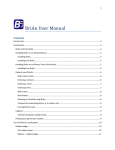

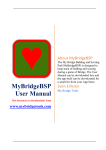

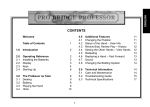
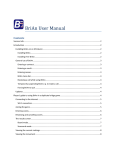

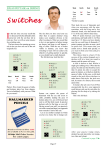
![Télécharger Pdf [2 700 Ko] - Groupement pour l`Amélioration de l](http://vs1.manualzilla.com/store/data/006468132_1-f9b1f24d8f5ebfc71b4689acb6a54463-150x150.png)
